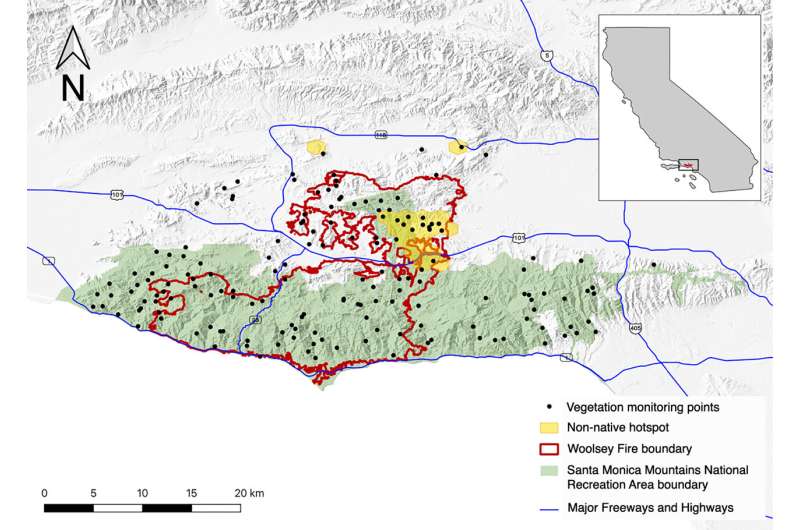This article has been reviewed according to Science X's editorial process and policies. Editors have highlighted the following attributes while ensuring the content's credibility:
fact-checked
peer-reviewed publication
trusted source
proofread
Rising non-native cover in the Santa Monica Mountains threatens native biodiversity and increases fire risk

The National Park Service has been monitoring plants in hundreds of sites throughout the Santa Monica Mountains National Recreation Area in Southern California since 2014.
A new analysis of these data published in the journal Ecosphere shows a steady increase in non-native plant cover since 2014, and rapid regrowth of non-native annual grass and herbaceous species after the 2018 Woolsey Fire, which burned nearly 80% of the entire region.
Furthermore, a region of dense non-native cover was found in the Northern Simi Hills region where biodiversity is significantly low and the native species are at risk of further reduction.
These results indicate that the Santa Monica Mountains are at high risk of losing the native plants that support their unique ecosystem. In addition, the invasive plants that are spreading bring with them an increased risk of damaging wildfires.
Healthy native plant communities are typically resistant to invasion since they are uniquely adapted to Southern California's dry climate. However, there has been a sharp increase in non-native cover from 4% in 2014 to 29% in 2018, before the Woolsey Fire. Ecosystem stressors such as changing climatic patterns, habitat fragmentation, and alterations in soil chemical properties reduce the resilience of the native plant communities and open the opportunity for invasion.
Nicoletta Stork, the lead author of the study and research analyst in Arizona State University's Center for Global Discovery and Conservation Science says, "The rise in non-native cover identified in this study is a signal of ecosystem stress from intrinsic and extrinsic factors. The prolonged effects of chronic ecosystem stress are still unknown, but this study has shown a glimpse of the negative repercussions at this moment in time."
Fire is typically beneficial for native plant communities in this region. However, when invasive seedbanks are prolific in the soil, the reduced shrub cover and newly available resources allow non-natives to germinate and spread. In the Santa Monica Mountains National Recreation Area, invasive non-native annual grasses and annual herbaceous plants regrew to exceed pre-fire cover percentages within a year after the Woolsey fire, reaching 34% in 2020, while native communities underwent natural, albeit slower, regrowth.
The speed at which non-natives regrew after the Woolsey Fire raises concerns as ecosystem stressors continue to affect native resiliency. Amy Mainzer, professor in the Lunar and Planetary Laboratory at the University of Arizona and co-author of the study notes, "This study shows that the weeds are spreading and becoming more prevalent in certain key areas after the fire, pointing to the need to locate and control them because they contribute to the increasing wildfires we are experiencing in the American Southwest."
The invasive annuals seen growing in the Santa Monica Mountains National Recreation Area accumulate layers of senesced plant material that is easily ignitable, creating a fire hazard that threatens property, the ecosystem, and human lives.
Other negative effects of non-native invasion include reduced biodiversity and altered ecosystems, therefore, locating regions with high non-native cover is crucial to controlling the spread of invasive populations. From this study, a non-native hotspot was located in the Northern Simi Hills region where non-native annual grass species were prominent before the fire. After the fire, certain invasive annual grasses increased, along with invasive mustard and thistle species.
Assessment of the species diversity in this hotspot shows the non-native community is significantly less diverse than native communities. Furthermore, while native communities have notably high shrub cover, non-native communities are comprised of highly flammable annual grasses and herbaceous species.
Robin Martin, associate professor in the School of Ocean Futures at Arizona State University and co-author of the study mentions, "Conversion from one functional group to another is another aspect that can give insight into how ecosystem structure is changing. In this case, the transition from perennial shrublands to annual grasslands could have significant effects on the ecosystem's hydrologic, carbon, and nutrient cycles, which can lead to more drastic positive feedback loops that eventually extinguish native species."
Monitoring efforts such as the Park Service's Inventory and Monitoring program provide insight into the non-native species that are most invasive and the native species that are most at risk of eradication or extinction. While more research must be done to identify the driving factors of invasive spread, studies like this one provide measures of how the ecosystem is changing over time and can point out the locations where management of invasive weeds is most essential.
More information: Nicoletta Stork et al, Native and non‐native plant regrowth in the Santa Monica Mountains National Recreation Area after the 2018 Woolsey Fire, Ecosphere (2023). DOI: 10.1002/ecs2.4567
Journal information: Ecosphere
Provided by Arizona State University


















